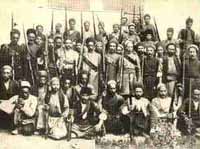Islamic Marxist
 The term “Islamic Marxist” was employed by SAVAK, the Shah’s secret police, to disparage political opponents of the monarchy. As explained by the "Economist" in 1978, the phrase was “in much vogue with the Shah and his subordinates.1 The PMOI was one of many opposition groups falsely tagged with the label. Even clerical members were not immune. Ayatollah Shariat Madhari was publicly branded as an “Islamic Marxist” after he turned against the Shah in 1978.2
The term “Islamic Marxist” was employed by SAVAK, the Shah’s secret police, to disparage political opponents of the monarchy. As explained by the "Economist" in 1978, the phrase was “in much vogue with the Shah and his subordinates.1 The PMOI was one of many opposition groups falsely tagged with the label. Even clerical members were not immune. Ayatollah Shariat Madhari was publicly branded as an “Islamic Marxist” after he turned against the Shah in 1978.2
Among the Shah’s political opponents were “leftist students, Western-educated liberals and other dissidents demanding more political freedoms.”3 News articles regularly grouped them together when mentioning political organizations in opposition to the Shah. It was not uncommon for the People’s Mujahedin to be listed in the same paragraph as the Tudah Party (Communist Party) and the Marxist People’s Fedayeen, giving the false impression their politics could be similar.
The People’s Mujahedin never referred to itself as Marxist and “intentionally shunned Marxist philosophy in order to protect its religious susceptibilities,” according to Ervand Abrahamian, an historian on Iran.4 Additionally, Abrahamian explained, “The [MEK] has in fact never once used the terms socialist, communist, Marxist or eshteraki [Communist] to describe itself.”5
 “As [PMOI leader Massoud] Rajavi admitted years later,” Abrahamian wrote, “the organization avoided the socialist label because such a term conjured up in the public mind images of atheism, materialism, and Westernism. For exactly the same reasons, the [Shah’s] regime was eager to pin on the [MEK] the label of Islamic-Marxist and Marxist-Muslims.”6
“As [PMOI leader Massoud] Rajavi admitted years later,” Abrahamian wrote, “the organization avoided the socialist label because such a term conjured up in the public mind images of atheism, materialism, and Westernism. For exactly the same reasons, the [Shah’s] regime was eager to pin on the [MEK] the label of Islamic-Marxist and Marxist-Muslims.”6
The People’s Mojahedin derives its political positions based on its interpretation of Islam. The original members of the group spent six years studying Islam, philosophy, history and economics. From this effort, they formulated a democratic and tolerant interpretation of Islam and a strategy to pave the way for a democratic government to replace the Shah’s dictatorial monarchy.
The PMOI believes Islam is an inherently tolerant and democratic religion and fully compatible with democracy, human rights, and the values of modern-day civilization. As explained by Mr. Rajavi in 1982:
“The Islam we want is nationalist, democratic, progressive, and not opposed to science or civilization. We believe that there is no contradiction between modern science and true Islam, and we believe that in Islam there must be no compulsion or dictatorship.”7
After the Shah was deposed, the PMOI worked to establish a democratic government. Ayatollah Khomeini and other mullahs wanted a fundamentalist theocracy. The two groups clashed. Just weeks after the Shah left Iran, the mullahs began to attack the PMOI, directing their Hazbollah gangs, called "club-wielders," to strike PMOI offices, rallies, and supports. The mullahs also replicated the name-calling propaganda tactic employed by the Shah, mislabeling the PMOI as Marxist. Mr. Rajavi discussed the false description of the Mojahedin in a 1981 interview:
“Every high school student knows that believing in God, Jesus Christ, and Muhammad is incompatible with the philosophy of Marxism. But for dictators like Khomeini, ‘Islamic Marxist’ is a very profitable phrase to use against any opposition. If Jesus Christ and Muhammad were alive and protesting against Khomeini, he would call them Marxists, too.”8
Since the mullahs came to power more than 30 years ago, they have relentlessly attacked the PMOI, mislabeling the organization as Marxist. As a result, many people have come to believe the falsehood. But nothing could be further from the truth. The mujahedin are freedom fighters, named after the mujahedin constitutionalists who came to the aid of Iran's first democratic government during the Constitutional Revolution of 1906-11. The PMOI specifically rejected Marxism. They offer a modern view of Islam and support democracy as the best way to solve Iran’s social and economic problems.
1) “Time and Oil Run Against the Shah,” The Economist, March 4, 1978
2) Ibid.
3) “An AP News Special,” Associated Press, November 9, 1978.
4) “The Iranian Mojahedin,” Ervand Abrahamian, Yale University Press, 1989.
5) “The Iranian Mojahedin,” Ervand Abrahamian, Yale University Press, 1989.
6) “The Iranian Mojahedin,” Ervand Abrahamian, Yale University Press, 1989.
7) “Mujahidin’s Masud Rajavi: “We are the only real threat to Khomeini,” MERIP Reports, March-April 1982.
8) “We Are On the Offensive,” Time magazine, September 13, 1981.
